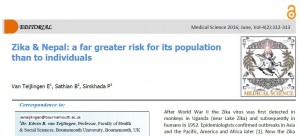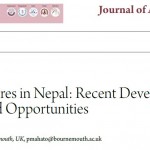 BU academics are editors on a wide range of scientific journals. As editors we often write editorials for academic journals which have a number of specific functions. It is a key means of communication between the editor(s) and the journal’s readership. It is also vehicle to highlight topical academic and political issues related to the journal and the discipline(s) it represents.
BU academics are editors on a wide range of scientific journals. As editors we often write editorials for academic journals which have a number of specific functions. It is a key means of communication between the editor(s) and the journal’s readership. It is also vehicle to highlight topical academic and political issues related to the journal and the discipline(s) it represents. 
Earlier this week the latest issue of the Journal of Asian Midwives came out with an editorial which is an illustration of the first point giving information to the readers [1]. The topics addressed in this editorial included the announcement that this new journal was now indexed in the CINAHL Database, a recent major international conference in the field and a call for the forthcoming 2017 ICM (Internation Confederation of Midwives) tri-annual conference. Today saw the publication of an editorial on the Zika virus and its potential impact in Nepal in the journal Medical Science [2]. This guest editorial co-written by BU’s Visiting Faculties Dr. Brijesh Sathian and Prof. Padam Simkhada with Prof. Edwin van Teijlingen (Centre for Midwifery, Maternal & Perinatal Health) calls for action in Nepal. A country where malaria is endemic. The Zika virus uses mosquitoes like the ones spreading Dengue fever and malaria. Zika is a virus we do not wish to see spreading in countries where malaria is already rife. The editorial warns that precautionary measures are needed to prevent a Zika outbreak as the spread of the virus to the country seems inevitable, the only uncertainty is when it will be arriving.
Both journals are Open Access which means these editorials can be read by anybody with internet access free of charge.
References:
- Jan, R., van Teijlingen, E. (2016) Editorial JAM June 2016, Journal of Asian Midwives 3(1):1. http://ecommons.aku.edu/jam/vol3/iss1/1/
- van Teijlingen, E., Sathian, B., & Simkhada, P. (2016). Zika & Nepal: a far greater risk for its population than to individuals. Medical Science 4(2): 312-313. http://www.pubmedhouse.com/journals/ms/articles/1064/PMHID1064.pdf
 New paper on Birthing Centres in Nepal
New paper on Birthing Centres in Nepal










 Upcoming opportunities for PGRs – collaborate externally
Upcoming opportunities for PGRs – collaborate externally BU involved in new MRF dissemination grant
BU involved in new MRF dissemination grant New COVID-19 publication
New COVID-19 publication Conversation article: London Marathon – how visually impaired people run
Conversation article: London Marathon – how visually impaired people run MSCA Postdoctoral Fellowships 2024
MSCA Postdoctoral Fellowships 2024 Horizon Europe News – December 2023
Horizon Europe News – December 2023